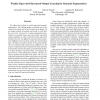Free Online Productivity Tools
i2Speak
i2Symbol
i2OCR
iTex2Img
iWeb2Print
iWeb2Shot
i2Type
iPdf2Split
iPdf2Merge
i2Bopomofo
i2Arabic
i2Style
i2Image
i2PDF
iLatex2Rtf
Sci2ools
CVPR
2012
IEEE
2012
IEEE
Weakly supervised structured output learning for semantic segmentation
We address the problem of weakly supervised semantic segmentation. The training images are labeled only by the classes they contain, not by their location in the image. On test images instead, the method must predict a class label for every pixel. Our goal is to enable segmentation algorithms to use multiple visual cues in this weakly supervised setting, analogous to what is achieved by fully supervised methods. However, it is difficult to assess the relative usefulness of different visual cues from weakly supervised training data. We define a parametric family of structured models, where each model weighs visual cues in a different way. We propose a Maximum Expected Agreement model selection principle that evaluates the quality of a model from the family without looking at superpixel labels. Searching for the best model is a hard optimization problem, which has no analytic gradient and multiple local optima. We cast it as a Bayesian optimization problem and propose an algorithm bas...
| Added | 28 Sep 2012 |
| Updated | 18 Oct 2012 |
| Type | Journal |
| Year | 2012 |
| Where | CVPR |
| Authors | Alexander Vezhnevets, Vittorio Ferrari, Joachim M. Buhmann |
Comments (0)




